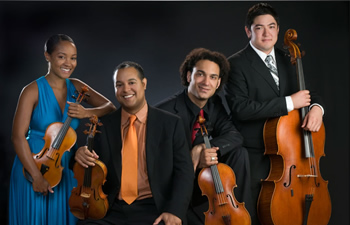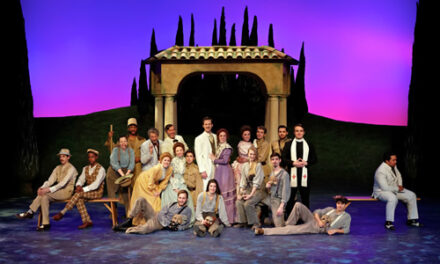UNCG Auditorium, formerly known as Aycock, was the venue for an effective and satisfying staging of Dialogues of the Carmelites, the second opera composed by Francis Poulenc (1899-1963). This production drew on the strengths of the School of Music, Theatre, and Dance. There was firm and imaginative leadership from David Holley, who served as stage director, producer, conductor, and music director. The effective and impressive multi-level set was designed by Amanda M. Warriner and skillfully lit by Louis Costanzo. Period costumes were designed by Deborah Bell. The important choral episodes in Act II – “Ave Maria” in Scene 2 and “Ave verum corpus” in Scene 4 – were prepared by Donna Rendely.
The opera is based on a slightly fictionalized account of the Martyrs of Compiégne, Carmelite nuns who were guillotined for refusing to renounce their vocations during the closing days of the Reign of Terror during the French Revolution in 1794. The libretto had its genesis in an abandoned screenplay by Georges Bernanos, based on a novella, Die Letzte am Schafott (The Last on the Scaffold), by Gertrude von Le Fort. Bernanos adapted his novella into a play seen by Margarita Wallman, wife of the president of the publishing firm Ricordi, which commissioned Poulenc to compose the opera. Though openly gay, the composer had recently rededicated himself to spirituality and Roman Catholicism. The influences of these elements are woven throughout the work.
The composer felt the opera’s “subject is grace and the transference of grace.” according to Roger Nichols in the program note of the Virgin Classics recording of the opera. Poulenc’s mastery is evident in his ability to set most of the text in recitative closely wedded to melodic lines. His vocal writing makes natural use of the rhythms and lyricism of the words. The harmonies are lush. The large orchestra is most often used in smaller groups for special colorings or effects. The composer’s treatment of woodwinds and brass is stylistically unique.
This production was sung in an English translation by Joseph Machlis with the text displayed as supertitles above the stage. Between Poulenc’s skillful use of the orchestra, conductor Holley’s measured balancing, and the uniform clarity of the casts’ diction, the supertitles were rarely needed.
The focus of the drama is the intense fear of the hypersensitive Blanche de la Force, who seeks sanctuary as a Carmelite nun, leaving her father and brother to become the last novice to serve under Madame de Croissy, the Old Prioress. Blanche becomes close to her fellow novice, Sister Constance, whose effusive optimism is her opposite in temperament. The Old Prioress entrusts special care of Sister Blanche to assistant prioress Mother Marie, who eventually commits the order to martyrdom while the New Prioress, Madame Lidoine, is away in Paris. The twelve scenes of the three acts delineate the rapid deterioration of conditions and the inevitability of the nuns’ deaths.
Baritone Nicholas Dankner’s use of body language helped bring the elderly Marquis de la Force to life. His firm, resonant voice clearly projected his lines. Derek Jackenheimer portrayed the Chevalier de la Force, Blanche’s brother, with a warm and even tenor voice that showed evidence of vocal reserves. The Nun’s Chaplin, tenor Jesse Herndon, had clear diction and modest projection.
The soprano voice of Shelley Marie Mihm had plenty of dramatic weight as she brought out the complexities of the role of the fearful Blanche de la Force. Her acting skills were most effective. Rachel Anthony sang the role of Sister Constance with a bright but warm and even light soprano. She was a constant cheerful and effusive foil for the fearful, withdrawn Blanche. Mezzo-soprano Emily Wolber Scheuring had the meaty role of the Old Prioress. She pulled out all the stops! Mother Marie, the ironical advocate of martyrdom, was beautifully sung by mezzo-soprano Megan Callahan. Soprano Lyndsey Swann brought plenty of vocal heft to the role of Madame Lidone, the New Prioress and reluctant martyr. The remaining Nuns were vocally well prepared.
Holley conducted a very skilled pit orchestra, the members of which were responsive to the score’s constant shifts of color and dynamics. The woodwinds and brasses were especially strong. The extensive oboe solo in Act III was sensitively spun by Brian Skinner. The percussive thuds, representing the guillotine’s fall as each Nun is executed, was effective. This had its impact heightened by having the Nuns leave the stage, via a bridge across the pit, and walking up the left aisle as they sang the “Slave Regina.” The multiple stairs leading to either end of the raised level were visually striking but a couple of Nuns came close to stumbling.
This performance was the last of the spring run of presentations of this great Poulenc opera.












